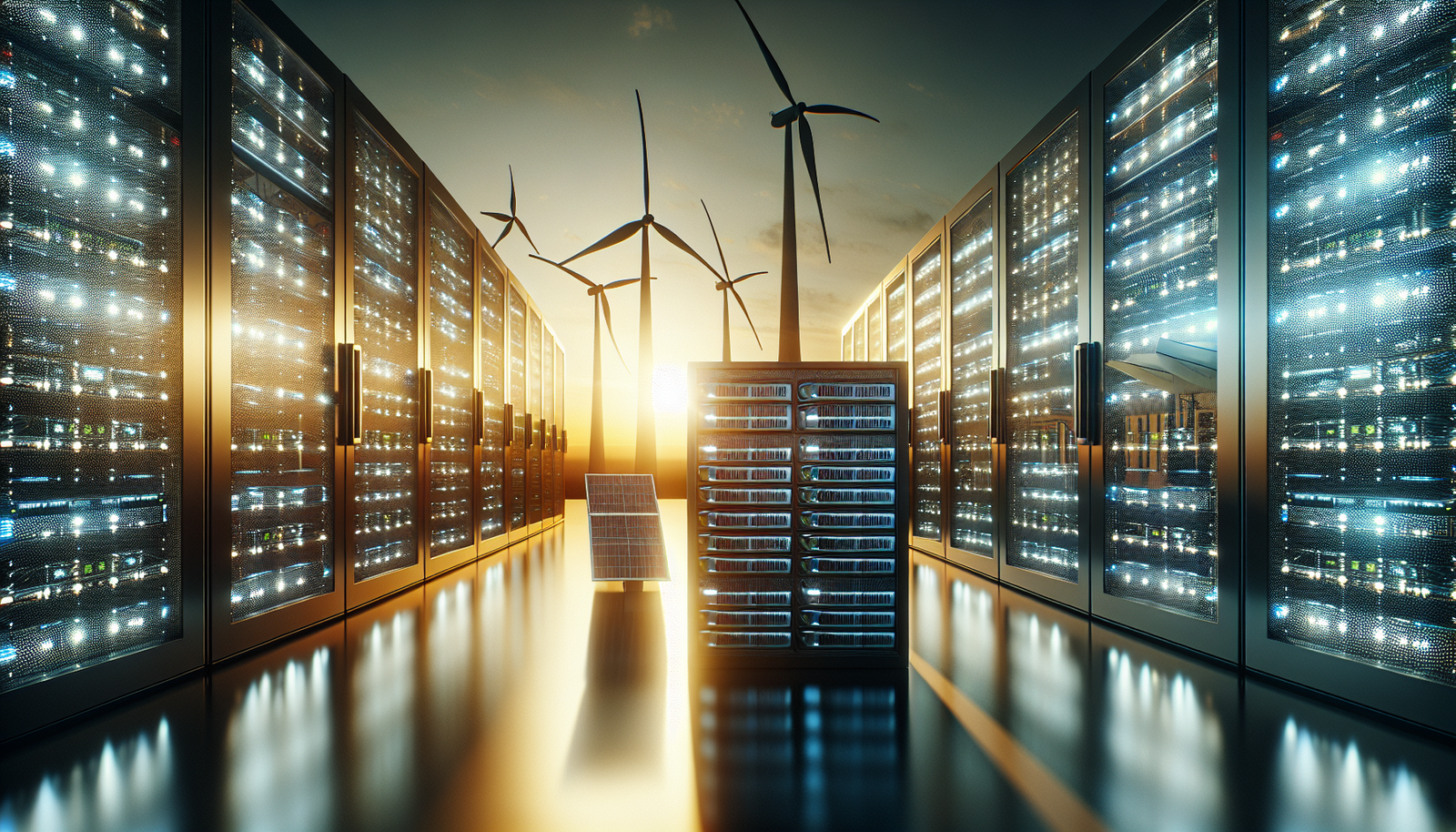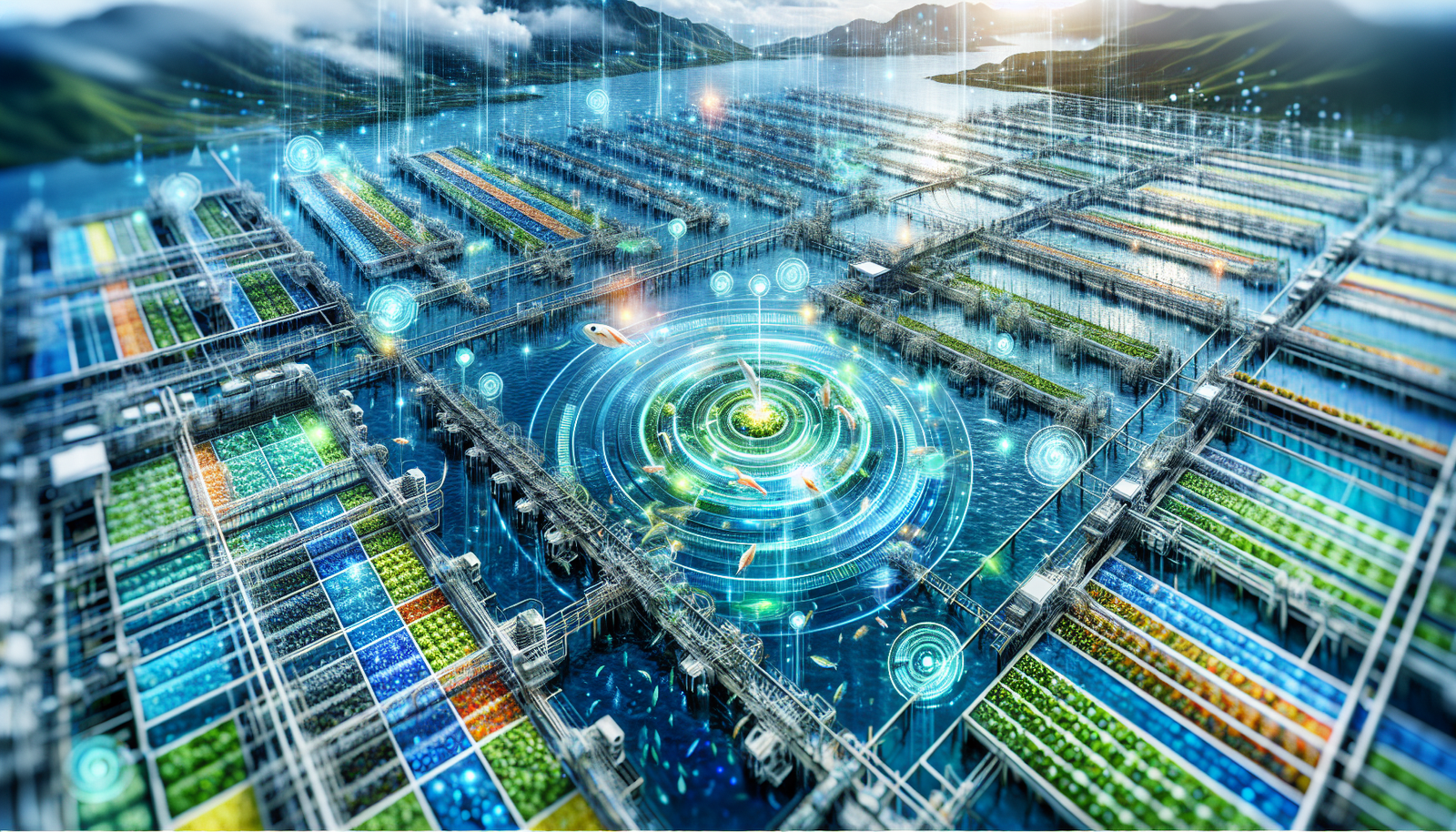Understanding AI’s Environmental Footprint
Artificial Intelligence (AI) has rapidly evolved to become a cornerstone of modern technological advancements, but its environmental footprint is a growing concern. The process of training AI models, especially deep learning models, is computationally intensive and requires significant amounts of energy. For instance, it has been reported that training a single AI model can emit as much carbon as five cars over their entire lifetimes. These emissions are primarily due to the vast data centers that power AI computations, which often rely on non-renewable energy sources.
Furthermore, the energy consumption associated with AI is not just limited to the training phase. Inference, or the process of using a trained model to make predictions, also demands substantial computational resources. This means that as AI applications become more widespread, the cumulative energy consumption will continue to rise. It is estimated that data centers worldwide consume about 1% of global electricity demand, a figure that is expected to double every four years. To illustrate the scale, consider the following table:
| Year | Global Data Center Energy Consumption (TWh) |
|---|---|
| 2010 | 194 |
| 2020 | 594 |
| 2030 (Projected) | 1,200 |
To mitigate these environmental impacts, it is crucial to adopt more sustainable practices in the development and deployment of AI technologies. One promising approach is the use of green data centers, which leverage renewable energy sources like wind and solar power. Companies are also exploring more energy-efficient hardware and algorithms to reduce the computational load. Another strategy involves the implementation of AI itself to optimize energy usage in various sectors, thus indirectly contributing to sustainability efforts.
In summary, while AI has a significant environmental footprint due to its energy-intensive processes, there are multiple strategies to balance this impact. By investing in renewable energy, optimizing data center efficiency, and using AI to drive sustainability initiatives, we can harness the power of AI while minimizing its environmental cost. Addressing the environmental footprint of AI is not only a technical challenge but also a critical step towards a more sustainable future.
The Energy Consumption of AI
Artificial Intelligence (AI) has revolutionized numerous sectors, but its energy consumption remains a significant concern. Training advanced AI models often requires vast amounts of computational power, leading to substantial energy usage. For instance, training a single AI model can consume as much power as several hundred households do in an entire year. The carbon footprint of training these models is correspondingly large, exacerbating environmental concerns. As AI continues to evolve, the demand for more powerful hardware and extensive datasets only increases, thereby amplifying its energy consumption.
One of the primary drivers behind AI’s high energy consumption is the need for large-scale data centers, which house thousands of servers. These data centers require continuous power not only to run the servers but also to cool them. According to recent studies, data centers worldwide account for about 1% of global electricity demand. This figure is expected to rise as the adoption of AI technologies grows. The challenge, therefore, is finding ways to mitigate this energy consumption without compromising the performance and advancements that AI brings.
Several strategies are being implemented to address this issue. Green data centers are emerging as a sustainable solution. These centers optimize energy use through various means, such as utilizing renewable energy sources like wind and solar power, and implementing advanced cooling techniques. Additionally, AI itself is being used to enhance the efficiency of these data centers by predicting and managing energy loads more effectively. Below is a table showcasing the energy consumption of traditional data centers versus green data centers:
| Type of Data Center | Average Energy Consumption (in MWh/year) | Carbon Emissions (in metric tons/year) |
|---|---|---|
| Traditional Data Center | 1000 | 500 |
| Green Data Center | 600 | 200 |
Another approach involves enhancing the efficiency of AI algorithms themselves. Researchers are developing more energy-efficient algorithms that require less computational power without sacrificing accuracy. Techniques such as model pruning, quantization, and the use of specialized hardware like AI accelerators are proving effective. By reducing the complexity of models and optimizing their performance, the overall energy consumption of AI can be significantly decreased. These efforts highlight the dual role AI can play in both driving energy consumption and offering solutions for greater sustainability.
Carbon Emissions and AI
Artificial Intelligence (AI) has become an integral part of modern technology, offering numerous benefits across various sectors. However, its deployment is not without environmental costs, specifically in terms of carbon emissions. The computational power required for training AI models, especially deep learning models, is immense. According to a study by the University of Massachusetts, training a single AI model can emit as much carbon as five cars over their entire lifetimes. This highlights the significant carbon footprint associated with AI technologies.
Energy Consumption: The energy consumption of AI systems is a primary contributor to their carbon emissions. High-performance computing hardware, such as GPUs and TPUs, consume vast amounts of electricity. For example, training large language models like GPT-3 can require energy equivalent to the annual consumption of several hundred households. This energy often comes from non-renewable sources, further exacerbating the environmental impact. To illustrate this, consider the following table showing the energy consumption of training various AI models:
| AI Model | Energy Consumption (kWh) | Carbon Emissions (kg CO2e) |
|---|---|---|
| ResNet-50 | 256 | 122 |
| GPT-3 | 1,287,000 | 626,155 |
| BERT | 656,000 | 319,186 |
Strategies for Mitigation: To mitigate the carbon emissions associated with AI, several strategies can be implemented. One approach is to optimize the efficiency of AI algorithms, reducing the computational power required without compromising performance. Companies can also invest in green data centers that utilize renewable energy sources. Furthermore, the use of AI in climate change mitigation efforts, such as optimizing energy grids and enhancing renewable energy forecasts, presents a way to offset its carbon footprint. The following are some key strategies:
- Improving algorithm efficiency
- Utilizing green data centers
- Leveraging AI for climate change mitigation
- Adopting renewable energy for AI operations
In conclusion, while AI technologies contribute to carbon emissions, there are viable pathways to reduce their environmental impact. By focusing on energy efficiency, renewable energy adoption, and leveraging AI for sustainability, it is possible to balance the benefits of AI with its environmental costs.
Sustainable AI: An Emerging Field
Sustainable AI is an emerging field that focuses on developing artificial intelligence technologies with a minimal environmental footprint. As AI technologies advance, their energy consumption and carbon emissions have raised concerns among researchers and policymakers. The goal of sustainable AI is to balance the benefits of AI-driven innovations with the need to protect our planet’s resources. This requires a multi-faceted approach, integrating energy-efficient algorithms, green data centers, and renewable energy sources.
One key aspect of sustainable AI is the development of energy-efficient algorithms. Traditional AI models, particularly deep learning networks, require substantial computational power, leading to high energy consumption. Researchers are now exploring ways to optimize these algorithms to reduce their energy demands. For example, techniques such as model pruning, quantization, and knowledge distillation can significantly lower the computational requirements without compromising performance. These advancements not only reduce the environmental impact but also make AI more accessible and cost-effective.
Another critical component of sustainable AI is the deployment of green data centers. Data centers, which house the servers and infrastructure necessary for AI operations, are notorious for their high energy use and carbon emissions. By adopting energy-efficient hardware, advanced cooling systems, and renewable energy sources, companies can drastically reduce the environmental impact of their data centers. According to a study by the Uptime Institute, implementing energy-efficient practices in data centers can reduce energy consumption by up to 40%. Additionally, some tech giants are committing to using 100% renewable energy for their data center operations, setting a precedent for the industry.
Finally, AI itself can play a pivotal role in climate change mitigation. By leveraging AI for predictive analytics, optimization, and automation, we can enhance the efficiency of various sectors, including transportation, agriculture, and energy. For instance, AI-driven systems can optimize supply chains to reduce waste, predict and manage energy usage more effectively, and improve crop yields through precise monitoring and resource allocation. These applications of AI not only contribute to sustainability but also demonstrate the potential of technology to address some of the most pressing environmental challenges of our time.
Green Data Centers: A Solution
As the demand for AI technologies grows, so does the need for data centers that can efficiently handle large volumes of data. Traditional data centers consume significant amounts of energy and contribute to high carbon emissions. However, green data centers are emerging as a sustainable solution to mitigate these environmental impacts. These facilities leverage advanced technologies and innovative designs to enhance energy efficiency and reduce their carbon footprint.
One of the key strategies employed by green data centers is the use of renewable energy sources. By harnessing solar, wind, and hydroelectric power, these data centers can significantly cut down on their reliance on fossil fuels. In addition, green data centers often incorporate energy-efficient cooling systems, such as liquid cooling and free cooling, which utilize natural airflows and temperatures to maintain optimal operating conditions without excessive energy consumption.
Another critical aspect of green data centers is their focus on resource optimization. This includes the implementation of virtualization technologies that allow multiple applications and systems to run on a single physical server. This approach not only reduces the number of physical servers needed but also maximizes the utilization of existing resources. Furthermore, green data centers often employ advanced monitoring and management systems to track energy usage and identify areas for improvement.
In addition to these technological advancements, green data centers are designed with sustainability in mind from the ground up. This includes the use of environmentally friendly building materials, efficient lighting systems, and water conservation measures. By prioritizing sustainability at every stage of their operation, green data centers can play a crucial role in balancing AI’s environmental impact with its sustainability benefits.
AI for Climate Change Mitigation
Artificial Intelligence (AI) is emerging as a potent tool in the fight against climate change, offering innovative solutions to reduce greenhouse gas emissions and enhance sustainability. One of the primary ways AI contributes to climate change mitigation is through advanced data analytics. By analyzing vast amounts of climate data, AI can predict weather patterns, optimize renewable energy sources, and improve disaster response strategies. For instance, AI algorithms can forecast solar and wind energy production, enabling better integration of these renewable sources into the power grid.
Moreover, AI can optimize energy consumption in various sectors. Smart grids powered by AI can dynamically balance supply and demand, reducing energy wastage. In manufacturing, AI-driven predictive maintenance can enhance the efficiency of machinery, leading to significant reductions in energy use. A study by PwC estimated that AI could help reduce global greenhouse gas emissions by up to 4% by 2030, primarily through these optimizations.
Additionally, AI is instrumental in the development of green data centers. These data centers leverage AI to optimize cooling systems, manage workloads efficiently, and reduce overall energy consumption. For example, Google’s DeepMind AI reduced the energy used for cooling its data centers by 40%. This not only lowers operational costs but also significantly cuts down on carbon emissions.
Furthermore, AI can enhance climate change research by processing and interpreting complex environmental datasets. AI models can simulate climate scenarios, assess the impact of various mitigation strategies, and identify the most effective actions. By providing policymakers with accurate predictions and actionable insights, AI ensures that climate policies are both effective and economically viable.
Optimizing AI Algorithms for Energy Efficiency
Optimizing AI algorithms for energy efficiency is a crucial step in balancing the environmental impact of artificial intelligence with its sustainability benefits. AI models, especially large-scale ones like deep learning networks, often require substantial computational power, leading to significant energy consumption. According to a study by the University of Massachusetts Amherst, training a single AI model can emit as much carbon as five cars over their lifetimes. Therefore, enhancing the energy efficiency of these algorithms is essential for reducing their carbon footprint.
One effective approach to optimizing AI algorithms is through algorithmic improvements. Techniques such as pruning, quantization, and knowledge distillation can significantly reduce the computational resources required for AI models. Pruning involves removing redundant neurons or connections in the neural network, while quantization reduces the precision of the numbers used in the computations, both of which lead to lower energy consumption. Knowledge distillation, on the other hand, involves training a smaller, more efficient model to replicate the performance of a larger one.
Another method is the use of hardware accelerators designed specifically for AI workloads. These include Graphics Processing Units (GPUs), Tensor Processing Units (TPUs), and other specialized hardware that offer higher efficiency and performance compared to traditional CPUs. By leveraging these accelerators, AI models can achieve faster computation times with lower energy usage.
In addition to these techniques, adopting green data centers can further enhance the sustainability of AI operations. Green data centers utilize renewable energy sources, efficient cooling systems, and innovative architectural designs to minimize their environmental impact. By hosting AI workloads in such data centers, organizations can ensure that the energy used for their computations comes from sustainable sources, thereby aligning with broader environmental goals.
Renewable Energy and AI
The integration of AI with renewable energy sources is proving to be a game-changer in the quest for sustainable development. AI technologies are being used to optimize the efficiency of renewable energy systems, such as wind turbines and solar panels. By analyzing vast amounts of data from weather patterns, energy usage, and equipment performance, AI can predict the best times to generate and store energy, thereby maximizing output and minimizing waste.
Energy Forecasting and Management
One of the key applications of AI in renewable energy is in energy forecasting and management. AI algorithms can predict energy production from renewable sources with high accuracy, helping grid operators balance supply and demand more effectively. This is particularly crucial for managing intermittent energy sources like solar and wind. For instance, AI can forecast solar energy production based on weather data, enabling better planning and integration into the grid.
Smart Grid Optimization
Another area where AI is making significant strides is in smart grid optimization. AI-powered smart grids can dynamically adjust to changing energy demands and supply conditions, ensuring a more resilient and efficient energy distribution network. With the help of machine learning models, smart grids can identify patterns and anomalies in energy usage, leading to proactive maintenance and reduced downtime. This not only enhances the reliability of renewable energy systems but also reduces operational costs.
- Improved energy storage solutions
- Enhanced predictive maintenance
- Optimized energy distribution
In conclusion, the synergy between AI and renewable energy promises a more sustainable and efficient future. By leveraging data and advanced algorithms, AI can significantly enhance the performance and reliability of renewable energy systems, contributing to a reduction in carbon emissions and a more sustainable energy landscape.
AI in Waste Reduction and Recycling
Artificial Intelligence (AI) plays a pivotal role in modern waste reduction and recycling efforts, offering innovative solutions to longstanding environmental challenges. By leveraging AI technologies such as machine learning and computer vision, waste management systems can become more efficient and effective. For instance, AI-powered robots are now being utilized in recycling facilities to sort through materials, identifying and separating recyclables from waste with greater accuracy and speed than human workers. This not only reduces the contamination of recyclable materials but also increases the overall recycling rate.
Moreover, AI-driven analytics can enhance the optimization of waste collection routes, reducing the fuel consumption and carbon emissions associated with waste transportation. Waste management companies can utilize predictive algorithms to forecast waste generation patterns and adjust their operations accordingly. This proactive approach minimizes the frequency of collection trips and ensures that resources are used more sustainably.
AI’s impact extends beyond mechanical sorting and logistical improvements. It also encompasses data analytics to track and monitor waste streams. By analyzing large datasets, AI can identify trends and anomalies in waste production, enabling municipalities and companies to implement targeted waste reduction strategies. For example, AI can help pinpoint areas with high levels of food waste, leading to initiatives that educate the public on proper food storage and consumption practices.
Additionally, the integration of AI in waste management supports the development of smart bins and IoT-enabled devices that provide real-time data on waste levels and types. These technologies facilitate more efficient collection schedules and reduce the overflow of waste, thereby minimizing environmental hazards. Smart bins equipped with AI can even offer feedback to users on proper recycling practices, fostering a more informed and environmentally conscious community.
Ethical Considerations in AI Development
When discussing the ethical considerations in AI development, it is crucial to acknowledge the dual-edged nature of this technology. On one hand, AI can significantly contribute to sustainability efforts, such as optimizing energy consumption in smart grids or improving the efficiency of supply chains. On the other hand, the development and deployment of AI systems often involve substantial energy consumption and carbon emissions. Therefore, balancing these aspects is not just a technical challenge but also an ethical imperative.
Transparency and Accountability are central to ethical AI development. It is essential to ensure that AI algorithms are transparent and that there is accountability for their environmental impact. Implementing robust auditing mechanisms can help track and mitigate the energy usage and carbon footprint of AI systems. Organizations can adopt green AI principles, which prioritize the development of energy-efficient algorithms. This approach not only minimizes environmental harm but also fosters trust among stakeholders.
Another critical ethical consideration is Equity and Inclusion. As AI technologies evolve, ensuring that their benefits are equitably distributed becomes paramount. This involves making green technologies accessible to underserved communities and ensuring that the environmental burdens of AI development do not disproportionately affect marginalized groups. A comprehensive ethical framework should include policies that promote social equity alongside environmental sustainability.
Finally, the concept of Intergenerational Responsibility should guide AI development. This principle emphasizes the obligation to consider the long-term environmental impact of AI technologies on future generations. Developers and policymakers should strive to create AI systems that not only meet current needs but also preserve the environment for future generations. By integrating these ethical considerations into AI development, we can create technologies that are both innovative and sustainable.
Case Studies: AI and Sustainability
The intersection of AI and sustainability is best illustrated through concrete case studies that highlight the real-world applications and outcomes. One notable example is Google’s DeepMind, which has utilized AI to significantly reduce energy consumption in data centers. By employing machine learning algorithms, DeepMind was able to predict and optimize cooling requirements, resulting in a 40% reduction in energy used for cooling and a 15% improvement in overall energy efficiency. This case study underscores how AI can contribute to substantial energy savings, thus mitigating its own environmental footprint.
Another compelling case study involves IBM’s Green Horizons initiative, which leverages AI to combat air pollution in China. By analyzing vast amounts of data from environmental sensors, weather stations, and satellite imagery, IBM’s AI models provide accurate air quality forecasts and actionable insights. This initiative has not only improved the accuracy of air pollution predictions but also helped policymakers implement more effective regulations, leading to a noticeable improvement in air quality in several Chinese cities.
AI’s role in sustainability extends to agriculture as well. John Deere, a leader in agricultural machinery, has integrated AI into its equipment to promote precision farming. Utilizing AI-driven sensors and machine learning models, John Deere’s technology can monitor crop health, predict yields, and optimize resource use. This approach reduces the need for water, fertilizers, and pesticides, thereby minimizing the environmental impact of farming and enhancing the sustainability of agricultural practices.
Lastly, Microsoft’s AI for Earth program demonstrates the broad potential of AI in addressing environmental challenges. This initiative supports projects that apply AI to various aspects of sustainability, including biodiversity conservation, climate change, and water management. For instance, one project uses AI to analyze satellite images for monitoring deforestation in real-time, enabling faster response to illegal logging activities. These case studies collectively illustrate how AI can be harnessed to drive sustainability across different sectors, balancing its environmental impact with significant sustainability benefits.
Future Prospects and Innovations in Sustainable AI
Future prospects in the realm of sustainable AI are vast, with ongoing research and development aiming to minimize the environmental footprint of AI technologies. Innovations in energy-efficient algorithms are a key focus area. Researchers are developing new methods to optimize algorithmic processes, reducing the computational power required for tasks without compromising performance. This not only lowers energy consumption but also decreases associated carbon emissions.
In addition to algorithmic improvements, the concept of green data centers is gaining traction. These facilities are designed to be environmentally friendly, utilizing renewable energy sources such as solar and wind power. They also incorporate advanced cooling techniques to reduce energy usage. For instance,
- Microsoft
- Amazon
have all made significant investments in renewable energy to power their data centers, which is a promising trend toward sustainable AI infrastructure.
Another exciting innovation is the use of AI itself to mitigate climate change. AI systems are being employed to optimize energy grids, predict and manage natural disasters, and enhance agricultural practices to ensure food security. By leveraging AI for these purposes, we can create a positive feedback loop where AI not only becomes more sustainable but also actively contributes to environmental conservation. A study by PwC indicates that AI could reduce global greenhouse gas emissions by up to 4% by 2030, highlighting its potential impact.
Moreover, collaborative efforts between academia, industry, and governments are crucial for advancing sustainable AI. Initiatives such as the
- Partnership on AI
- AI for Earth
- Climate Change AI
are fostering collaboration and knowledge sharing. These partnerships are essential for developing standardized practices and policies that ensure AI technologies are both effective and sustainable in the long run.



